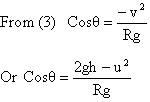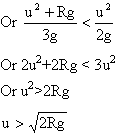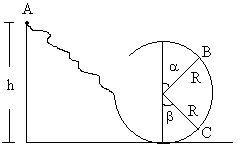Work Power Energy -5
Derivation:
Motion in a vertical circle:
A particle of mass m is attached to inextensible light string of length l and it is imparted a velocity u in horizontal direction lowest point. Let v be its velocity at point B of circle.
Fig (23)
Here h = R (1-Cosq) ------------ (1)
By conservation of mechanical energy ![]()
![]()
Necessary centripetal force is provided by the resultant of tension T and mgCos![]()
![]()
Now three condition arise depending on u,![]()
The string does not stuck at highest point if T ![]() 0 at
0 at ![]() =
=![]() ,
,
So substituting T = 0 and ![]() =
=![]() for completing the circle in (B)
for completing the circle in (B) (At highest point)
(At highest point)
And h = 2R
So from equation (2)![]()
Or ![]()
Or ![]()
![]() the particle will complete the circle.
the particle will complete the circle.
Substituting q = 00 and v = u = ![]() in equation (3) we get T = 6mg. So in the critical condition tension in the string at lowest position is 6mg.
in equation (3) we get T = 6mg. So in the critical condition tension in the string at lowest position is 6mg.

Fig (24)
Putting T = 0 before reaching highest point for

Substituting in equation (1) we get

Velocity of particle becomes zero when
0 = u2-2gh
Now the particle will leave the circle if tension in the string becomes zero but velocity is not zero or,
T = 0 but v 0 this is possible only when
h1<h2

Therefore if
The particle will oscillate if velocity of the particle becomes zero but tension in the string is not zero.
V = 0 but T
h2 < h1

Further if h1 = h2,
Illustration:
A ball of mass m slides without friction down a path from height h and then moves in loop of radius ![]() Find the force exerted on the ball by the track at B and at C
Find the force exerted on the ball by the track at B and at C
Fig (27)
Solution:
Fig (28)
For maintaining circular motion net centripetal force must be greater than ![]()
On applying energy conservation between point A and C we get
On solving ![]()
From f.b.d of body ![]()
On solving FB=3mg (1+Cosb)
Similarly for point B
mg [h-(R+RCosa)] = ![]() (energy equilibrium)
(energy equilibrium)![]()
![]() FB = 3mg (1-Cosa)
FB = 3mg (1-Cosa)